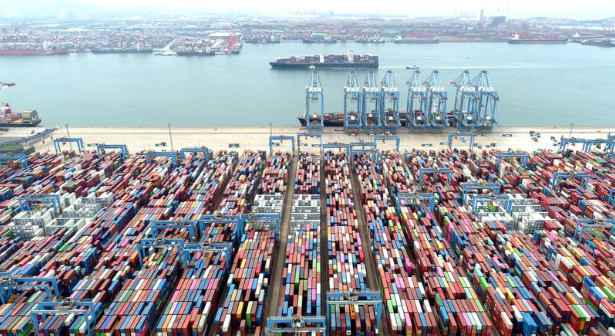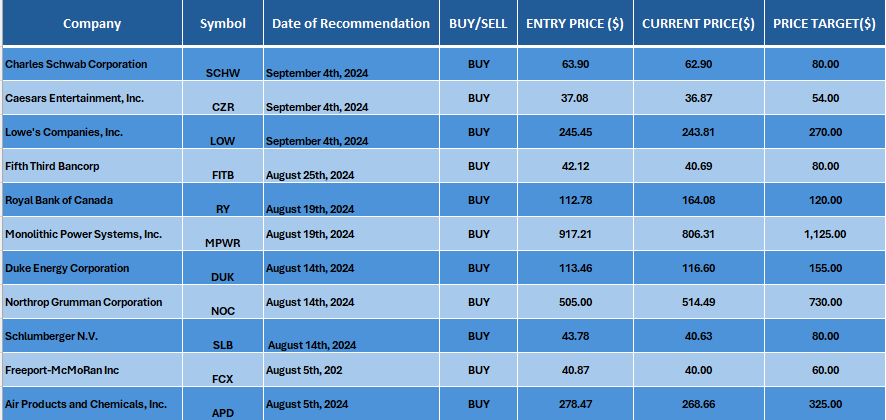
Date Issued – 1st October 2024
Preview
As Q4 unfolds, global markets are facing heightened volatility driven by a combination of factors, from labor strikes in the U.S. to geopolitical tensions in Asia, alongside significant shifts in energy markets and technology sectors. Presenting both challenges and opportunities for discerning investors.
U.S. Port Strike: Significant Disruption to Global Supply Chains
At midnight on October 1, 2024, the International Longshoremen’s Association (ILA) officially initiated a strike across 36 major U.S. ports, stretching from Texas to Maine. This historic labor action, the first of its kind in nearly five decades, has already caused widespread disruption to global supply chains. With more than 45,000 dockworkers walking off the job, industries across the spectrum—from consumer goods and electronics to manufacturing and automotive—are scrambling to adjust.
The strike stems from a breakdown in negotiations between the ILA and the U.S. Maritime Alliance (USMX), with key sticking points including demands for wage increases that exceed the 32% previously granted to West Coast dockworkers and strong resistance to further automation of port operations. The ILA argues that automation threatens job security and will erode worker protections unless reined in.
This strike comes at a particularly critical time as the U.S. heads into its peak holiday shopping season. Many retailers were building up inventory in anticipation of higher demand, but the strike threatens to delay shipments of goods ranging from apparel to consumer electronics. With more than half of U.S. ports now paralyzed, this bottleneck could exacerbate inflationary pressures in an already volatile economy.
Impact on Key Sectors
- Logistics and Transport: Companies offering alternative transportation solutions such as air freight, rail, and inland shipping are likely to experience a surge in demand. Investors should consider increasing exposure to firms in these industries, as they stand to benefit from this sudden disruption.
- Consumer Goods and Retail: Companies reliant on just-in-time inventory models, particularly in the consumer goods and technology hardware sectors, will likely experience significant volatility. Expect delayed shipments, reduced inventory levels, and potential price hikes in the near term.
- Inflation Hedge: As shipping costs rise and product shortages emerge, inflationary pressures may increase. Reassessing positions in inflation-protected securities or commodities that benefit from inflationary trends could be a wise strategy.
China’s Economic and Geopolitical Pressures: The South China Sea and Economic Weakness
In the Asia-Pacific region, tensions have escalated dramatically over the last 24 hours as China launched extensive naval drills in the South China Sea. These drills are seen as a direct response to joint military exercises by the U.S., Japan, and the Philippines, highlighting the growing geopolitical rivalry between China and the West.
The South China Sea is a critical trade corridor through which an estimated one-third of global shipping passes. Any prolonged disruption in this area could lead to significant supply chain delays, particularly for energy resources and semiconductors, where global markets are already experiencing shortages. In response, China has continued to assert its territorial claims, heightening the risk of a potential conflict in the region.
At the same time, China’s domestic economy is facing mounting challenges. Recent data points to continued weakness in its property market, sluggish industrial output, and soft consumer demand. Beijing has responded with a series of economic stimulus measures, but so far, these have failed to provide the desired boost. This economic slowdown, combined with growing external pressures, raises concerns about China’s ability to maintain growth in the near term.
Key Considerations for Investors
- Geopolitical Risk: Investors with significant exposure to Asia, particularly in sectors like energy, technology, and shipping, should closely monitor developments in the South China Sea. Any disruption in this key maritime route could have a profound impact on global supply chains, especially for semiconductors and energy resources.
- China’s Economic Outlook: While China’s longer-term growth prospects in areas like renewable energy and technology innovation remain compelling, the near-term outlook is clouded by economic weakness. Investors may want to reassess their exposure to China’s real estate and industrial sectors and consider shifting allocations to regions such as India or Southeast Asia, which offer more favorable growth dynamics at present.
- Defensive Sectors: As geopolitical tensions rise, defense contractors, cybersecurity firms, and companies involved in critical infrastructure may see heightened demand for their services, presenting potential upside in a volatile environment.

European Energy Crisis: Bracing for a Tough Winter
As winter approaches, Europe is once again facing an energy crunch. The ongoing impact of the reduced flow of Russian natural gas into the region has left many European nations scrambling to secure alternative energy supplies. Although renewables are gaining ground, the transition to a fully decarbonized energy system is slow, and natural gas remains critical to meet short-term energy demands.
Germany, France, and Italy are among the most vulnerable to energy shortages, and energy prices are expected to rise significantly as colder weather sets in. This, in turn, will impact energy-intensive industries like manufacturing, chemicals, and transportation, where high energy costs could squeeze profit margins.
Impact on Key Sectors
- Energy Sector: Renewable energy stocks, energy storage solutions, and LNG infrastructure companies are positioned to benefit from the current energy transition. European governments are pushing for faster adoption of renewables, and companies involved in solar, wind, and energy storage could see long-term growth opportunities.
- Commodities and Inflation Hedge: Rising energy costs in Europe may lead to a knock-on effect on commodity prices, including oil, natural gas, and industrial metals. Investors looking for a hedge against rising inflation and energy shortages should consider diversifying into energy commodities and commodity-focused ETFs.
- Green Energy Transition: The European Union continues to push for a green energy future, and sectors aligned with the decarbonization agenda—including electric vehicles (EVs), energy-efficient technologies, and clean energy infrastructure—are expected to see accelerated investment. This creates long-term opportunities in sustainability-focused companies.
Technology Sector: AI and Semiconductors Dominate the Spotlight
Despite broader market volatility, the global technology sector continues to shine. Driven by the rapid advancement of artificial intelligence (AI), cloud computing, and semiconductor technologies, tech companies are once again leading the charge. Demand for AI-related products and services is booming across multiple industries, from healthcare and finance to logistics and autonomous vehicles.
Major semiconductor manufacturers are reporting robust earnings, as the need for more powerful AI chips drives record sales. Companies involved in developing next-generation AI models, quantum computing, and advanced semiconductor materials are expected to see continued growth well into 2025.
However, regulatory risks remain a key consideration for tech investors. Both the U.S. and European Union are increasingly scrutinizing big tech companies, and the introduction of new regulations could slow growth for some of the sector’s largest players.
Key Considerations for Investors
- AI and Semiconductors: Investors should consider increasing exposure to companies at the forefront of AI innovation, including those involved in developing AI chips, machine learning models, and cloud infrastructure. Semiconductor companies with strong fundamentals are particularly well-positioned to benefit from rising demand for AI applications.
- Tech Regulations: Stay alert to potential regulatory shifts in the U.S. and Europe. While the growth potential for AI and tech remains high, new regulations could introduce unforeseen hurdles for major players, particularly in areas like data privacy and anti-monopoly actions.
- Diversification: Balancing exposure to both high-growth tech stocks and more stable sectors—such as utilities, consumer staples, and healthcare—could help mitigate the volatility that often accompanies periods of rapid technological innovation.
Closing Thoughts: Positioning for Resilience and Growth
In conclusion, the global investment landscape is increasingly complex, marked by labor disruptions, geopolitical tensions, and shifting economic fundamentals. Navigating these challenges requires a careful balance of short-term tactical moves and long-term strategic positioning.
The U.S. port strike and supply chain disruptions present near-term risks but also open up opportunities in logistics and alternative transport sectors. China’s economic slowdown and South China Sea tensions require a reassessment of exposures to the region, with a potential focus on diversifying into other emerging markets. Europe’s energy crisis underscores the need to explore renewable energy investments and commodities as inflation hedges, while the tech sector continues to offer compelling growth opportunities driven by AI and semiconductor advancements.
As always, we are here to help you navigate these complex markets and ensure your portfolios are positioned for resilience and growth in these dynamic times. If you have any questions or would like to discuss portfolio adjustments, please don’t hesitate to reach out.
Upcoming Dates to Watch
- October 10: U.S. Federal Reserve releases meeting minutes, potentially offering insights into future interest rate policies.
- October 20: EU summit on energy, where key decisions regarding long-term energy security strategies will be made.
- Q4 2024: China’s quarterly GDP figures are released, providing a clearer picture of the country’s economic trajectory.
Find below some of our Buy/Sell Recommendations. Balfour Capital Group is a distinguished global boutique investment management firm with $400 million AUM and over 1000 Clients.

Disclaimer: This post provides financial insights for informational purposes only. It does not constitute financial advice or recommendations for investment decisions.

